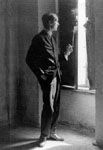 The
final phase of East German photography developed in response to this
ideological split. Unwilling to limit themselves to ZKF sanctioned
subjects and quick to respond to issues of postmodernism, during the
1980s photographers created work that was critical of socialist policy
and state control of the arts. Although very little such critical
work ever saw the light of day in East Germany, from the mid 1980s
onward Die Fotografie's editorial staff was emboldened by the
need for a liberal journal within the increasingly international forum
for photographic art. Indeed, in a period of growing social turmoil,
periodicals such as Die Fotografie attempted to show the progressive
side of East German cultural politics, promoting a view of liberal
socialism both at home and abroad. Thus, at a time when only private
exhibition spaces and samizdat publications were willing to present
the work of young photographers such as Micha Brendel, Matthias Leupold,
and Erasmus Schröter inside East Germany, Die Fotografie
was among the few organs of the state to present the same work (albeit
in weaker and smaller doses) to international audiences.
The
final phase of East German photography developed in response to this
ideological split. Unwilling to limit themselves to ZKF sanctioned
subjects and quick to respond to issues of postmodernism, during the
1980s photographers created work that was critical of socialist policy
and state control of the arts. Although very little such critical
work ever saw the light of day in East Germany, from the mid 1980s
onward Die Fotografie's editorial staff was emboldened by the
need for a liberal journal within the increasingly international forum
for photographic art. Indeed, in a period of growing social turmoil,
periodicals such as Die Fotografie attempted to show the progressive
side of East German cultural politics, promoting a view of liberal
socialism both at home and abroad. Thus, at a time when only private
exhibition spaces and samizdat publications were willing to present
the work of young photographers such as Micha Brendel, Matthias Leupold,
and Erasmus Schröter inside East Germany, Die Fotografie
was among the few organs of the state to present the same work (albeit
in weaker and smaller doses) to international audiences.
 The
greatest legacy of the ZKF to the history of photography was its recognition
that "aside from minor beginnings, there are no investigations
and representations of the history of photography from the Marxist-Leninist
point of view." (DF 1/66, p. 8). After the Cultural Conference
of 1960, the ZKF attempted such an investigation in Die Fotografie,
extensively revisiting the histories of early Soviet photography and
German worker photography, and re-examining the work of such artists
as Lewis Hine, August Sander, Eugene Smith, and others for their contribution
to its origins. Die Fotografie also allied with the periodicals
Soviet Foto (USSR), Foto (Hungary), and Czechoslovakian
Fotografie (CSSR), and began to present individual and mixed portfolios
by international artists working in the revolutionary tradition. Similarly,
the ZKF, in cooperation with the cultural ministries of other Warsaw
Pact nations, sponsored a series of exhibitions, such as Bifota
and Interpress, which focused on "the humanistic ideas
of peace, of friendship among the peoples, and of human happiness."
These exhibitions were extensively documented by Die Fotografie.
Works by exhibitors were published alongside articles by ZKF representatives
describing their contribution to the evolving socialist aesthetic.
The
greatest legacy of the ZKF to the history of photography was its recognition
that "aside from minor beginnings, there are no investigations
and representations of the history of photography from the Marxist-Leninist
point of view." (DF 1/66, p. 8). After the Cultural Conference
of 1960, the ZKF attempted such an investigation in Die Fotografie,
extensively revisiting the histories of early Soviet photography and
German worker photography, and re-examining the work of such artists
as Lewis Hine, August Sander, Eugene Smith, and others for their contribution
to its origins. Die Fotografie also allied with the periodicals
Soviet Foto (USSR), Foto (Hungary), and Czechoslovakian
Fotografie (CSSR), and began to present individual and mixed portfolios
by international artists working in the revolutionary tradition. Similarly,
the ZKF, in cooperation with the cultural ministries of other Warsaw
Pact nations, sponsored a series of exhibitions, such as Bifota
and Interpress, which focused on "the humanistic ideas
of peace, of friendship among the peoples, and of human happiness."
These exhibitions were extensively documented by Die Fotografie.
Works by exhibitors were published alongside articles by ZKF representatives
describing their contribution to the evolving socialist aesthetic.

